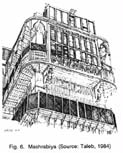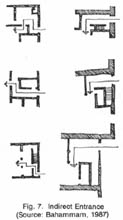Religion and Guide For Living
2.1 Introduction
An understanding of Islam as a religion is necessary in order to comprehend its effect on the built environment. Islam is the second largest of the world's religions numbering in excess of 800 million Muslims and 45 Muslim countries that extend from North Africa to South East Asia.

Islam is a monotheistic religion which arose in the deserts of Arabia in 600 A.D. Its founder was the Prophet Muhammad (peace be upon him). The message of God revealed to him is contained in the holy book, the Quran. The Prophet's (pbuh) sayings, deeds and teachings are recorded by his followers and compiled in the Hadith. These two books guide the Muslim from the cradle to the grave in all religious and secular activities. The religious laws and legislation cover all areas of political, economic, social and personal life to the minutest detail. According to Ahmed A.S.(1988), Islam is not simply a religion, it represents a whole sense of community and a way of life. It defines both a world view and a guidance framework for action in all spheres of life.
[ TopOfPage(); ]2.2 Segregation of Women in Islam
Before the advent of Islam in the Arabian Peninsula, women were regarded as mere chattel, to be bought and sold like any other property. Infant daughters were often buried at birth. Women had no right of property and inheritance.
Islam uplifted the status of women at that time (7th C. A.D.) as full-fledged members of society with certain rights and obligations. These rights includedthe rights to be educated, to inherit, to divorce. Women were given the right to participate in debates and public discussions, to involve themselves in public political affairs and to participate in electing the highest government officials. At the same time, certain restrictions on the behaviour of both men and women led to the segregation of women from male members of society both at public and private levels. Although women often took active part in public life in the early days of Islam, gradually, in most Islamic societies, they were restricted to the bounds of the women's domain - the harem and to an almost total absence in public areas. At present, as A.S. Ahmed points out, the actual situation of women, their social status and privileges, is far removed from the Islamic ideal, whether in the tribe, village and city. Deprived of economic and heriditary rights, trailing far behind men in education, women are formed into an inferior class. According to Ahmed, a major reason for this is that whenever Islamic societies came under stress (for example foreign colonization), its customs became more rigid, forcing women to "hide behind veils and remain invisible in the courtyards of their homes."
[ TopOfPage(); ]2.3 Relevant Teachings in Islam
Muslims seek guidance in all the spheres of their life activities from the holy Quran or the Hadith. With regards to seclusion, women are advised as follows:
Stay quietly in your houses, and make not a dazzling display, like that at the former times of ignorance. (Surah Al Ahzaab, verse 33)
In the Hadith the following rules are laid down for observance of purdah:
Women should stay home in all dignity and since there are restrictions on their mobility, no duty is alloted to them which requires them to go out of the house. A women should always confine herself to domestic obligation and duties. If the women has to go out in unavoidable circumstances, she must be simply attired.
Islam makes it haram (prohibited) for women to wear clothes which fail to cover the body, which are transparent and which delineate the parts of the body. The Quran advices the Muslim women to be conservative in their appearance:
O Prophet, tell thy wives and thy daughters and the women of the believers to draw their cloaks close around them (when they go abroad) that will be better, so that they may be recognised and not annoyed. (Surah Al Ahzaab, verse 59)
It is therefore required for a Muslim woman when she goes out to wear a dress that covers her from head to foot and does not reveal her figure. According to some scholars only the hands and face should be left uncovered, while according to some others the face should also be uncovered.
Many religious scholars have interpreted these teachings as meaning that women should be unobtrusive and subdued, both in private and public areas. In "Purdah", (1970) Abdul Ali Maududi interprets verse 31 of Surah al-Nur.
Tell Muslim women to cast down their eyes and to protect their chastity. They should not expose their beauty. They should cover themselves properly. The people or men before whom they can come are her husband, father, father-in-law, son, stepson, brother, nephew, servant and pre-adolescent boys. Order the women that while they walk, they should not strike the ground so hard with their feet, so that the beauty they possess may get exposed by the noise of their walk. They should talk softly and they should cover themselves with a chadar (veil) before going out.
Men have also been advised as to their conduct regarding the segregation of women. The Prophet said:
Whoever believes in Allah and the Last Day must never be in privacy with women without their being a mahrem (of hers) with her, for otherwise Satan will be the third person (with them).
Purdah became an indispensable part of Muslim social structure because of the higher status that was attributed to families which observed it. The Prophet (pbuh) instructed the women of his family and his tribe to veil themselves while making public appearances in order to distinguish the women in the family from those of other families. In time, this was taken up by other families. Thus the use of the veil not only meant segregating the females from males but implied high breeding and high family status. Veiling and seclusion regulations can be diregarded only during times of war and emergencies and when a woman's life and chastity are in danger.
[ TopOfPage(); ]2.4 Women's Domain in the Islamic House
Housing and the neighbourhood are very visible products of Islamic thought and custom. In different Islamic cultures there are vast differences in religious, social and cultural mores, but the common faith has resulted ingeneral similarities in dwelling design from one end of the Islamic world to the other. This is true in almost all Islamic cultures, whether nomadic, rural or urban.
The seclusion of women from certain categories of men is an important factor in the use of household space and the orientation of dwellings with respect to one another.

As a general rule men and women are in two separate domains. Toulan (1980) says, "The need to separate women was reflected in the design of the typical house." Even in the minimal portable tent "a clear segregation of sexes is obtained by the use of dividing partitions, and each part would furthermore be provided with its own entrance."
The women's activities are centered around the private life of the family, hidden from the public eye. The man has more interaction with the public realm and the important obligation of hospitality gives rise to the necessity of spaces to receive guests. The concept of a male guest house or reception room is widely distributed throughout the Islamic world. In Southern Iraq, for example, there is usually a free-standing guest house in every village, but sometimes part of the dwelling is partitioned off and turned into a male guest-house (the mudhi f), with separate entrances for both domains.

The most common dwelling form, however, is the inward looking courtyard house, which supports the family and social functions. Closed to the outer world, it opens towards a central court, thus fullfilling the need for privacy as well as for adequate light and ventilation. This dwelling type appears to be the universal solution in the Islamic world. It supports the division of the home into a public and a secluded family section. (Fig. 4) In larger houses, the two domains are arranged around two separate courtyards.

Apart from the courtyard house, Islamic teachings have been the basis of several additional architectural devices and elements which reinforce the concept of seclusion and concealment of women.
* Minimum windows to the exterior, small in size
* Mashrabiya, screened windows, which allow women to look out without being seen
* Indirect entrances to dwellings, usually from a corner; separate entrances for women.
* High roof parapets to allow private use of roofspace
Public areas in the Muslim world are defined, among other ways, by the absence of women. Women usually do not visit the mosques, bazaars, public gatherings or coffee houses. When women participate in public congregations or institutions, there are often separate screened-off spaces for their use or separate facilities. They go out on the streets only when necessary and even then with the protection of the veil. In many Muslim countries separate transportation is provided for women, such as ladies' buses or reserved train compartments.
[ TopOfPage(); ]2.5 Summary of Findings
The separation of male and female domains in the home is not confined to the Islamic world. This spatial separation can also be seen in the traditional architecture of other cultures, such as in China and Greece . But in Islamic societies, it is more or less a common identifiable feature. In countries as widely apart as Morocco and Indonesia, dwellings exhibit a striking similarity in layout and organisation. Different cultures and both primitive and more advanced urban societies in the Islamic world share the concept of confining women in specified spaces within the home, albeit with obvious regional differences. Inspite of considerable cultural differences, the design and layout of the typical Muslim home reflects and facilitates the segregation and seclusion of women.
This special and almost universal characteristic of the Islamic home can be explained when it is understood as a manifestation of some special teachings and interpretations of the Islamic faith. The teachings of the Islamic faith influence and guide its followers in all spheres of religious and secular activities and maintain social order by providing guidelines and control mechanisms for individual behaviour. The conceptual similarity in the built environment of the followers of Islam have to be understood as an expression of a common faith and a unifying religious culture.
[ TopOfPage(); ]


